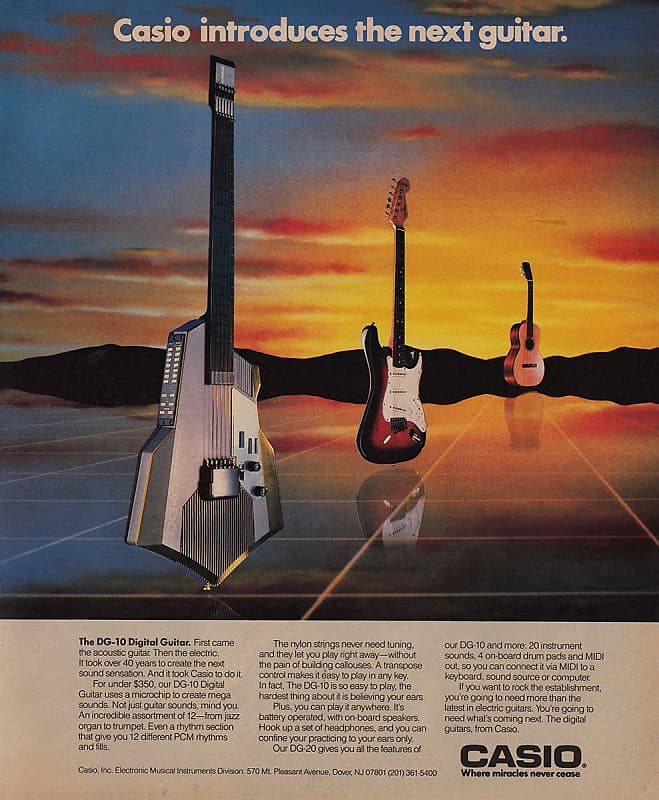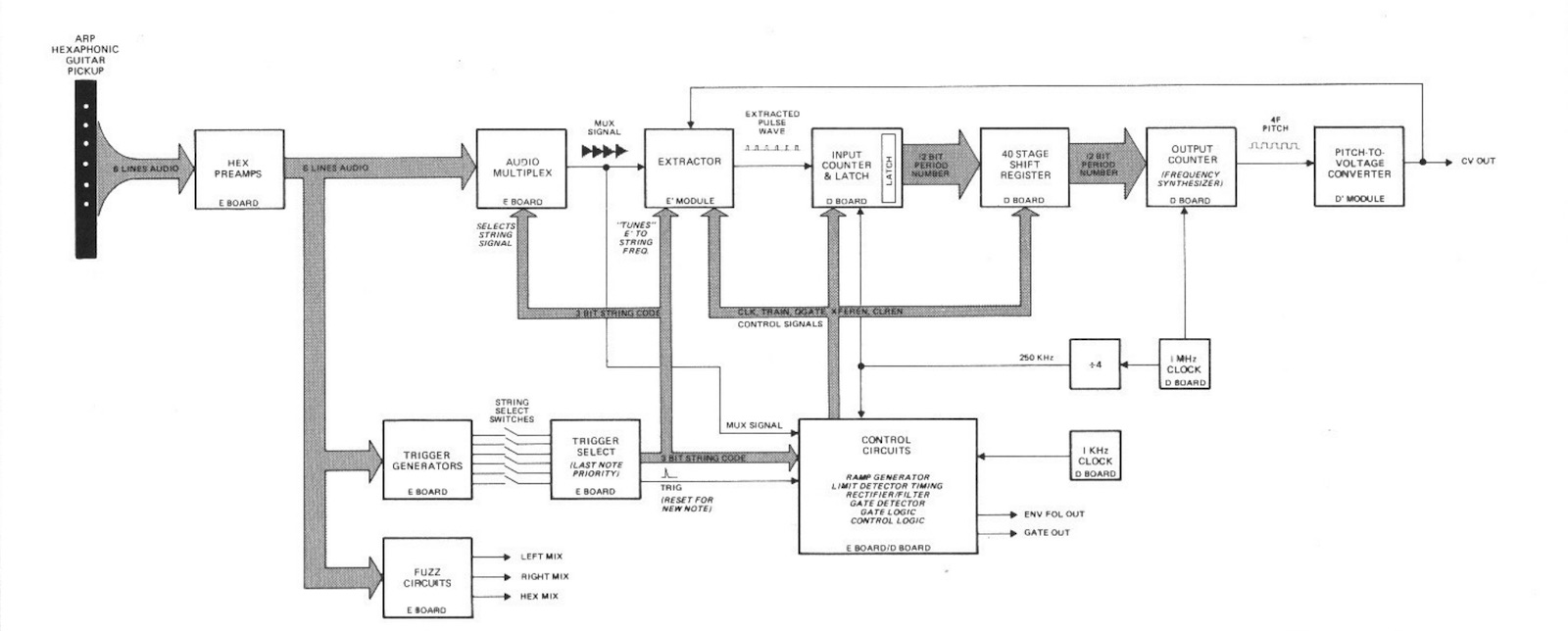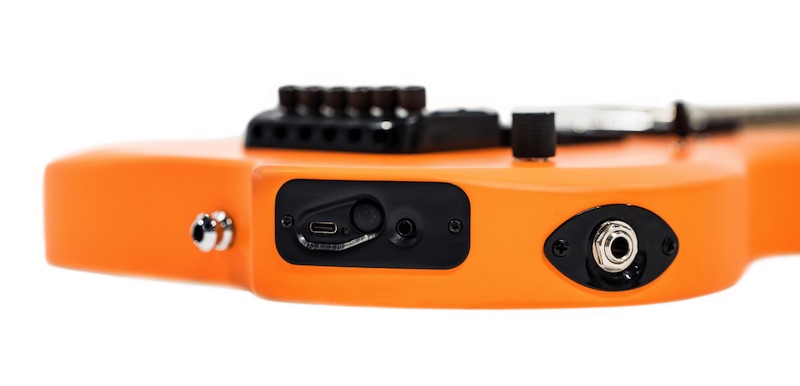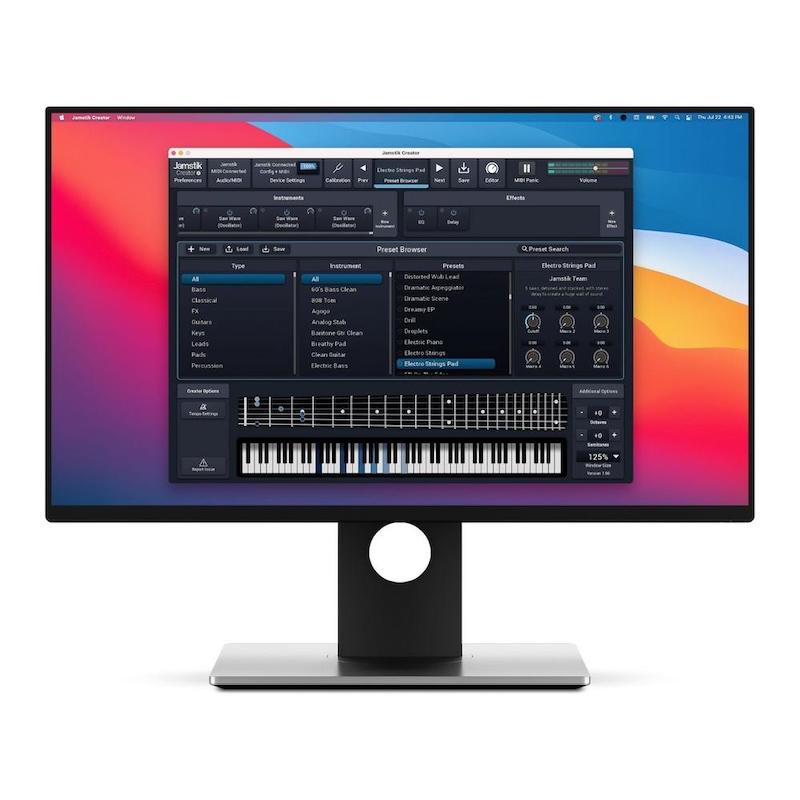While we're all undoubtedly infatuated with synthesizers, effects, and music production in general—it may not be quite as obvious to the outsider that many of us at Perfect Circuit began our musical lives as guitarists. For some of us, the guitar has remained a lifelong tool for expression; some of us more or less abandoned guitar in favor of exploring electronic music; and yet others have returned to the guitar after a hiatus, and have recently been rediscovering it—finding new ways to integrate it into our practice as electronic musicians.
As such, we were thrilled to recently receive a batch of Jamstik Studio guitars—a fully-featured electric guitar with integrated MIDI and MPE functionality. As soon as these guitars arrived, we broke one out and stress-tested the heck out of it, finding that under most normal circumstances, it works surprisingly well...and while we've only had them for a short while, we're super impressed with what they can do and are excited to continue our personal experiments with them.
Happily, we recently hosted Dex and Jake, two of Jamstik's product specialists, who were able to talk us through the general idea and workflow of the Jamstik, complete with jams pairing it with some of our favorite MPE-capable gear. Check out the video above and, if you want to learn more about why and how someone turned a guitar into a MIDI controller, read on!
Are You Telling Me You Built a MIDI Controller...Out of a Stringed Instrument??
So, let's take things back a couple of steps. Let's say you're getting into electronic music, or the world of music production in general. One of the first pieces of gear many of us get—even before an audio interface—is a MIDI controller. It's a simple, straightforward way of getting specialized, hands-on control of your computer, transforming an everyday tool into a musical instrument and efficient production environment. That makes a lot of sense...but if you look at the landscape of available MIDI controllers, what are your options? Most controllers are pad-based control sources or keyboard controllers; and while these do work quite well, they don't necessarily immediately serve the expertise of every musician. After all, plenty of us get started making music on acoustic instruments well before we approach electronic music. So...why aren't there more controllers out there that leverage the expertise and dexterity of already skillful musicians? (Note: if you find that an interesting idea, check out the article in which Sarah Belle Reid and I expand on the idea of augmented acoustic instrument controllers!)
 An ad for Casio's guitar-like DG-10 & DG-20—particularly peculiar instruments/controllers produced in the 1980s
An ad for Casio's guitar-like DG-10 & DG-20—particularly peculiar instruments/controllers produced in the 1980s
Well, in short, there have been a lot of attempts at making augmented instruments which can easily interface with electronic devices through various means. However, few of these are as technologically simple/elegant/easy to implement as a mechanical keyboard, which is effectively not so different from a large series of black and white buttons. Moreover, the keyboard was generally seen as a fairly universal, relatable playing interface while synthesizers and commercially-produced electronic instruments were in their infancy. So, given this ease of implementation and relative universality, the way synthesizers work altogether evolved along with their typical attachment to a keyboard. Eventually, MIDI was developed to act as a universal communication scheme between musical instruments...and because it was developed at a time when synthesizers had become increasingly keyboard-centric, it brought with it many concepts and assumptions that were intrinsically tied to the use of keyboards. This results in a number of subtle quirks that may go unnoticed entirely when using a keyboard to play a synthesizer—but when connecting a guitar-like controller, the player's feeling of connection to the sound become a bit uncanny and uncomfortable.
So, to recap: we suppose that the relative dominance of keyboards as controllers has to do with a perceived universality of the black-and-white keyboard, the ease of translating that mechanical user interface from an acoustic into an electronic medium, and the eventual standardization of MIDI, which in many ways privileges keyboard-oriented playing styles. That isn't to say that guitar-based controllers have never existed, of course—in fact, engineers and musicians have been developing guitar-oriented controllers for nearly as long as synthesizers have existed. Especially in the 1970s and 1980s, products like ARP's Avatar (control scheme image below) and Roland's GR synthesizers and GK pickups made great advanced toward this end, allowing guitarists to use specialized hardware in order to get their hands around electronic soundmaking. (Another note: check out our article on audio-controlled synthesis for more detail on this weird corner of electronic music history!)

One of the weird deficiencies of MIDI that has historically made devices like these somewhat awkward, though, is that traditionally, MIDI is quite clumsy at handling per-note changes in pitch/timbre/etc. without affecting all other simultaneous notes. For instance, try holding down a chord on a typical synth/MIDI controller and using the pitch bend wheel: odds are that when you do this, all notes of the chord bend equally. However, it's critical to guitar and other string instruments that pitch (and various other aspects of timbre) be independent for each note altogether—allowing bends on one string without bending all others, or simply allowing a different style of articulation for multiple simultaneous or overlapping notes. Luckily, the official adoption of MPE (MIDI Polyphonic Expression) into the MIDI specification has provided a clever, efficient, and standardized way to work around the interdependence between notes, finally allowing for a much finer degree of per-note expression while still using plain old MIDI (see our article What is MPE? for more detail on how this works).
While MPE has mostly relied on the creation of novel new control surfaces such as the Roger Linn Designs LinnStrument or Sensel Morph, the creators of the Jamstik Studio MIDI Guitar realized that this new control protocol could hold the potential for overcoming the decades-long struggle of building an effective guitar MIDI controller—an instrument that not only looks and plays sort of like a guitar (cough cough, Casio DG-20), but an instrument that actually is a guitar, designed from the ground up to work well in modern production environments. So without further delay, let's get to the point—what is the Jamstik Studio MIDI Guitar?
What is Jamstik Studio? It's a Guitar!
So yes—Jamstik Studio is a fully-featured MIDI controller with MPE capability. Much of the media out there surrounding this device seems to hinge on its novelty from the perspective of guitarists—oh whoa it's a guitar that can do MIDI stuff!—but coming from the perspective of people who routinely play, use, and review MIDI controllers, it's quite an astonishing and elegant accomplishment. Let's talk first about Jamstik Studio as a guitar, and then dive deeper into its MIDI specs.
First things first, Jamstik Studio may look and feel quite small—but in actuality, it's a full-size and quite comfortable instrument. It has a 24-fret neck with a full 25.5" scale length, but its ~3/4 body size leaves it a mere 32.5" long and 5.5lbs, making it a quite light and compact instrument that doesn't compromise on playing comfort. It has a 1.75"-wide rosewood fretboard with a comfortable-yet-quite-flat 13.78" radius on a C-shaped maple neck and a mahogany body. If you're not primarily a guitarist, allow me to translate: this guitar is made of high-quality materials, and it was designed to be compact, yet still comfortable for any guitarist to play.
In terms of electronics, it features two humbucker pickups with a three-way toggle selector, allowing for a wide range of clean, low-noise tones. There's no master tone control, but it does feature a master volume knob with a push-pull pot in order to coil tap the pickups, allowing for twangier, brighter sounds from each pickup. The headless design uses an (included) allen key for tuning, and has quite excellent tuning stability.
A dedicated audio output allows you to use this like an entirely normal electric guitar because, frankly, it is one: you could use this instrument as a guitar without ever even exploring its MIDI functionality. While it is a fully capable and well-made, comfortable, and good-sounding guitar, we do suspect it's unlikely anyone would choose this as their sole instrument based on its being a guitar alone—but I could certainly imagine myself being quite content taking it on the road as a compact yet satisfying tool to efficiently bridge my needs for a guitar and a way of controlling electronic instruments. In that way, this would make a heck of a touring instrument for folks responsible for both guitar and synth duties in a band, for instance. But all its features as a guitar aside, let's dig into the really interesting part: its capabilities as a MIDI controller.
What is Jamstik Studio? It's a MIDI Controller!
Jamstik Studio is a fully-featured controller that can transmit MIDI data via USB-C, Bluetooth, or a 3.5mm TRS MIDI output (via the included 3.5mm to DIN MIDI cable). Its internal electronics use a rechargeable battery, and allow for continuous operation even when charging via the USB port. But you might be asking yourself...how do you build a guitar into a MIDI controller?

The Jamstik Studio uses a classic approach common to many such devices in the past: a special hexaphonic pickup mounted near the bridge that independently detects the sounds/vibrations of each string. This isn't a new idea...but previous iterations of this concept from Roland and others often hinged on installing a pickup on your own guitar which, in practice, didn't always work out well: if the distance between your strings wasn't just so, it could be difficult to get a consistent response on all strings. By removing the guesswork and building the pickup into a guitar of their own design, Jamstik has circumvented this issue entirely, making setup absolutely painless. It's quite effective even right out of the box.
The Jamstik Studio contains an onboard processor with proprietary converters and extensive custom algorithms for translating pitch and playing gestures into usable MIDI data. Because it's based on detecting the pitch/articulation of each independent string (rather than being based on detecting a player's finger positions, for instance) it can achieve a number of quite remarkable things, and its MIDI behavior can mirror important idiomatic aspects of guitar playing in a number of ways difficult to achieve with other controllers. For instance, the system is quite good at detecting and translating a variety of playing techniques, including hammer-ons and pull-offs, tapping, muting, and even natural & artificial harmonics—all quite impressive.
Of course, one of the most significant ramifications of this design is that it adapts to MPE format quite gracefully. There are some fundamental differences between this guitar's MPE capabilities and a standard MPE controller, but all things considered, the compromises it makes are perfectly fine and honestly, quite interesting.

So, most MPE controllers detect five "dimensions" of touch (as seen in Roger Linn's diagram above), allowing you to derive five independent-but-related control streams from each point of contact with the instrument. These dimensions are: strike velocity, lateral movement (X-axis position), vertical movement (Y-axis position), pressure (Z-axis position), and release velocity. On such controllers, strike velocity is interpreted as typical MIDI velocity data; the X-axis is usually mapped to pitch bend relative to the current note; and Y and Z-axes are mapped to some aspect of timbre. (Release velocity can be implemented in a number of ways, but often isn't even utilized.) The Jamstik Studio guitar, though, doesn't have multidimensional touch sensors at each fret—it's all based on extrapolating data from the sound of each independent string. As such, there's no way to actually detect physical X/Y/Z movement.
However, you can detect the current pitch and the deviation of that pitch from a standard MIDI note—which is enough to extrapolate usable note and pitch bend data from each string. You can also detect the loudness/immediacy of a note's onset, allowing you to extrapolate velocity data. And, additionally, Jamstik allows detection of the instantaneous loudness/"note decay" of each string—which isn't a standard MPE parameter per se, but actually quite a clever and relevant parameter for this application. This means that you can actually use the continuous loudness/decay of each note as a per-note modulation source: so, depending on the instrument you're controlling, this could be mapped to brightness, to modulation rates, or to any aspect of the sound. Given that guitarists are accustomed to the feeling and sound of manipulating a string's continuous decay, this can make the feeling of using Jamstik quite natural—and in the best situations, it can help you feel more physically connected to the electronic sounds you're creating. So, despite Jamstik Studio not employing what we might think of as a "typical" MPE implementation, it does offer a clever exploitation of MPE's structure, in turn providing gestural data detection uniquely relevant to the guitar paradigm. I can't stress enough how clever, interesting, and downright useful this is.

Of course, even if you don't want to get deep into the weeds of experimenting with MPE implementation, Jamstik Studio can still be profoundly useful. The Jamstik Creator software is a standalone application and a plugin for your DAW, serving multiple purposes in customizing your experience with the device. It is a fully functional synthesizer with a dedicated editor, allowing you to create and control sounds from the application itself—and perhaps more importantly, it contains all of the facilities you need to customize the guitar's MIDI response to your personal playing style, from global and per-string sensitivity adjustment, tuning utilities, alternate tuning setup, sensor calibration, and a number of ways of customizing the MIDI data output. You have options for standard MIDI operation in addition to MPE, and even a multi-channel mode in which each string has its own constant MIDI channel (whoa). You can also fine-tune pitch bend range, the string decay modulation routing, and much more—all with the aid of a simple, straightforward GUI.
So What Do We Think of Jamstik Studio?
So what do we think? Well, especially considering the price, the Jamstik Studio MIDI Guitar's performance is pretty amazing. We found that it played well out of the box, but for our purposes, it benefitted quite a bit from adjusting string sensitivity to our own playing styles. Some non-standard playing styles (fingerstyle, heavily palm muting) didn't translate perfectly—but we found that it was quite easy to adjust our natural playing style to "play to" the Jamstik, so to speak. After a little bit of adjustment, it plays quite well.
The MPE response is definitely one of the most interesting features for our purposes, and one that we'll likely continue to explore. Out of the box, polyphonic pitch bend information works excellently—but we've only just begun to explore the possibilities of using string decay as a control source, and we're quite sure this will prove to lead us to bizarre new options for guitar-controlled synthesis. Paired with a Hydrasynth or OB-6, for instance, this could be a ton of fun. We're also curious to explore the fixed-channel-per-string MIDI option: what would it sound like for each string to play a completely different synthesizer or drum machine? Hopefully we'll soon be able to figure this out.
Another important question: could we see ourselves using this guitar? Yeah, absolutely. Having this sophisticated a MIDI control source built into a fully functional guitar sends my head reeling with ideas—being able to blend a heavily effect-laden guitar with a synchronized synthesizer, being able to play chords and synthesizer arpeggios simultaneously, being able to play a drum machine and guitar simultaneously—these are all inspiring ideas that we're excited to explore. We're sure that this guitar will prove a convenient tool for guitarists looking for new ways of interacting with their computer and other electronic instruments, but as people who identify equally as synthesizer players and guitarists, the Jamstik Studio MIDI Guitar is a promising bridge between two separate halves of our musical practice. That said, if you're looking to bring guitar and your electronic music practice together, this guitar presents an excellent and just plain fun opportunity.








